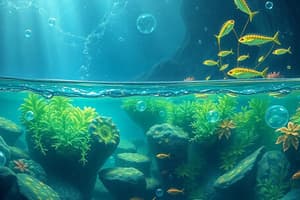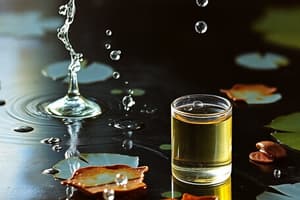Podcast
Questions and Answers
What is the chemical formula for water?
What is the chemical formula for water?
H2O
What makes water a polar molecule?
What makes water a polar molecule?
Oxygen is more electronegative than hydrogen, creating a partial negative charge on the oxygen atom and a partial positive charge on the hydrogen atoms.
What type of bonds are formed between water molecules?
What type of bonds are formed between water molecules?
Hydrogen bonds
Which of the following molecules would be considered hydrophilic?
Which of the following molecules would be considered hydrophilic?
Which of the following is NOT a property of water?
Which of the following is NOT a property of water?
What allows for capillary action in water?
What allows for capillary action in water?
Energy can be created or destroyed.
Energy can be created or destroyed.
What is the relationship between structure and function in biological molecules?
What is the relationship between structure and function in biological molecules?
Which of the following is NOT a biological macromolecule?
Which of the following is NOT a biological macromolecule?
What is the significance of carbon in biological macromolecules?
What is the significance of carbon in biological macromolecules?
Which of the following processes involves the removal of a water molecule?
Which of the following processes involves the removal of a water molecule?
What is the chemical formula for carbohydrates?
What is the chemical formula for carbohydrates?
Which of the following is a function of carbohydrates?
Which of the following is a function of carbohydrates?
Which of the following is a polysaccharide?
Which of the following is a polysaccharide?
What is the difference between starch and cellulose?
What is the difference between starch and cellulose?
What is the main function of lipids?
What is the main function of lipids?
Which of the following is an example of a saturated fat?
Which of the following is an example of a saturated fat?
What is a phospholipid?
What is a phospholipid?
Which of the following is NOT a type of steroid?
Which of the following is NOT a type of steroid?
What are the four levels of protein structure?
What are the four levels of protein structure?
What is the role of R groups in amino acids?
What is the role of R groups in amino acids?
Which of the following interactions is NOT involved in tertiary structure?
Which of the following interactions is NOT involved in tertiary structure?
What is protein denaturation?
What is protein denaturation?
Which of the following is NOT a component of a nucleotide?
Which of the following is NOT a component of a nucleotide?
What is the difference between DNA and RNA?
What is the difference between DNA and RNA?
Which of the following pairs of nitrogenous bases are found in DNA?
Which of the following pairs of nitrogenous bases are found in DNA?
What is the difference between prokaryotic cells and eukaryotic cells?
What is the difference between prokaryotic cells and eukaryotic cells?
Which of the following is NOT an example of a prokaryotic cell?
Which of the following is NOT an example of a prokaryotic cell?
What is the function of ribosomes?
What is the function of ribosomes?
What are the two main types of functional groups?
What are the two main types of functional groups?
Which of the following functional groups is non-polar?
Which of the following functional groups is non-polar?
What is a hydroxyl group?
What is a hydroxyl group?
What is the difference between a carbonyl group and a carboxyl group?
What is the difference between a carbonyl group and a carboxyl group?
What is an amino group?
What is an amino group?
What is a phosphate group?
What is a phosphate group?
What is a sulfhydryl group?
What is a sulfhydryl group?
What type of bonds form between water molecules?
What type of bonds form between water molecules?
Which describes molecules that interact well with water?
Which describes molecules that interact well with water?
Which term describes the attraction between water molecules?
Which term describes the attraction between water molecules?
Which term describes the attraction between a water molecule and another polar surface?
Which term describes the attraction between a water molecule and another polar surface?
What is the ability of water to dissolve other substances called?
What is the ability of water to dissolve other substances called?
Ice is less dense than liquid water.
Ice is less dense than liquid water.
What process allows water to travel upwards against gravity?
What process allows water to travel upwards against gravity?
What is energy?
What is energy?
The principle of conservation of energy states that energy can be created or destroyed.
The principle of conservation of energy states that energy can be created or destroyed.
What does the phrase "structure=function" mean in biology?
What does the phrase "structure=function" mean in biology?
Which of these is NOT a biological macromolecule?
Which of these is NOT a biological macromolecule?
What element forms the backbone of biological macromolecules?
What element forms the backbone of biological macromolecules?
What terms describe the small units and large chains formed from these units in macromolecules?
What terms describe the small units and large chains formed from these units in macromolecules?
What process forms a bond between two monomers?
What process forms a bond between two monomers?
What is the general chemical formula for carbohydrates?
What is the general chemical formula for carbohydrates?
Which of these is a function of carbohydrates?
Which of these is a function of carbohydrates?
What are the monomers of carbohydrates called?
What are the monomers of carbohydrates called?
Which polysaccharide stores glucose in plants?
Which polysaccharide stores glucose in plants?
Which polysaccharide stores glucose in animals?
Which polysaccharide stores glucose in animals?
Which polysaccharide serves as a structural component in plant cell walls?
Which polysaccharide serves as a structural component in plant cell walls?
What type of linkage bonds monosaccharides together?
What type of linkage bonds monosaccharides together?
What macromolecule category includes fats and oils?
What macromolecule category includes fats and oils?
Flashcards
H2O
H2O
The chemical formula for water.
Significance of Water in Biology
Significance of Water in Biology
Water is essential for most biological processes, making up a large portion of most biological environments.
Oxygen
Oxygen
Oxygen is an electronegative atom, meaning it attracts electrons more strongly than hydrogen. This creates a partial negative charge on the oxygen atom in a water molecule.
Hydrogen
Hydrogen
Signup and view all the flashcards
Polarity of Water
Polarity of Water
Signup and view all the flashcards
Hydrogen Bonds
Hydrogen Bonds
Signup and view all the flashcards
Hydrophilic
Hydrophilic
Signup and view all the flashcards
Hydrophobic
Hydrophobic
Signup and view all the flashcards
Cohesion
Cohesion
Signup and view all the flashcards
Adhesion
Adhesion
Signup and view all the flashcards
Surface Tension
Surface Tension
Signup and view all the flashcards
Solvency of Water
Solvency of Water
Signup and view all the flashcards
Density of Ice
Density of Ice
Signup and view all the flashcards
Temperature Regulation
Temperature Regulation
Signup and view all the flashcards
Capillary Action
Capillary Action
Signup and view all the flashcards
Energy
Energy
Signup and view all the flashcards
Conservation of Energy
Conservation of Energy
Signup and view all the flashcards
Structure=Function
Structure=Function
Signup and view all the flashcards
Biological Macromolecules
Biological Macromolecules
Signup and view all the flashcards
Carbon
Carbon
Signup and view all the flashcards
Monomer
Monomer
Signup and view all the flashcards
Polymer
Polymer
Signup and view all the flashcards
Dehydration Synthesis
Dehydration Synthesis
Signup and view all the flashcards
Removal of H2O
Removal of H2O
Signup and view all the flashcards
Hydrolysis
Hydrolysis
Signup and view all the flashcards
Significance of Water in Hydrolysis
Significance of Water in Hydrolysis
Signup and view all the flashcards
Carbohydrate Chemical Formula
Carbohydrate Chemical Formula
Signup and view all the flashcards
Elements found in Carbohydrates
Elements found in Carbohydrates
Signup and view all the flashcards
Study Notes
Water in Biology
- Water's chemical formula is H₂O.
- Biological systems largely consist of water, with interactions involving it vital for life.
- Water's polarity stems from oxygen's electronegativity, making the oxygen side slightly negative and the hydrogens slightly positive.
- Hydrogen bonds—weak attractions between water molecules—result from this polarity, crucial for water's properties.
- Hydrophilic molecules interact favorably with water; hydrophobic molecules do not.
- Cohesion describes hydrogen bonds between water molecules; adhesion describes bonds between water and other polar surfaces.
- Cohesion leads to surface tension, making water's surface difficult to break.
- Water's polarity and hydrogen bonds give it high solvency, dissolving many substances, a "universal solvent".
- Ice is less dense than liquid water due to hydrogen bonding, a key factor in aquatic life, allowing life beneath the ice.
- Water's high specific heat and high heat of vaporization help regulate temperature, essential for homeostasis.
- Capillary action combines cohesion and adhesion to allow water to move against gravity in narrow tubes.
- Water is essential for all biological environments and interactions.
Biological Macromolecules
- Macromolecules are essential for an organism’s function, and are made up of Carbon, Hydrogen, Oxygen, and other elements.
- Carbon is central to macromolecule structure, forming up to four covalent bonds, creating carbon skeletons.
- A monomer is a single unit in a macromolecule.
- Polymers are large molecules formed by joining monomers.
Carbohydrates
- Carbohydrate chemical formula is C₆H₁₂O₆.
- Carbohydrate elements are carbon, hydrogen, and oxygen.
- Carbohydrates function as energy storage, structural materials, and raw materials.
Types of Carbohydrates
- Monosaccharides are simple sugars, the monomers of carbohydrates.
- Polysaccharides are complex carbohydrates like starch, glycogen, cellulose, and chitin, consisting of many monosaccharides.
- Glucose is a common monosaccharide; isomers have identical formulas but different structures.
- Starch is a plant energy storage polysaccharide (linear); glycogen is an animal energy storage polysaccharide (branched).
- Cellulose forms plant cell walls (linear, with beta linkages); chitin is found in exoskeletons and fungal cell walls (beta structure).
- Alpha glucose forms starch and glycogen; beta glucose forms cellulose and chitin.
- Glycosidic linkages are covalent bonds between monosaccharides, formed by dehydration synthesis.
Lipids
- Lipids are mainly composed of carbon and hydrogen, with some oxygen.
- Fats are made up of glycerol and fatty acid tails, functioning in long-term energy storage, insulation, and cushioning.
- Ester linkages bind glycerol to fatty acids.
- Saturated fats have no C=C double bonds (straight chains); unsaturated fats have C=C double bonds (bent chains).
- Phospholipids are key components of cell membranes. (glycerol + 2 fatty acids + phosphate group).
- Steroids have four fused carbon rings and include cholesterol, which is crucial for cell membranes.
Proteins
- Proteins are highly diverse biological macromolecules composed of CHON and sometimes sulfur.
- Amino acids are the monomer units of proteins, with each distinct R group, which determines function.
- Polypeptides are polymers of amino acids.
- Peptide bonds link amino acids.
- The polypeptide backbone is the repeating N-C-C sequence in a protein chain.
- N-terminus and C-terminus are the ends of a polypeptide chain.
- A protein's primary structure is its unique amino acid sequence.
- The secondary structure involves local folding like alpha helices and beta pleated sheets.
- Tertiary structure is the overall 3-D shape of a polypeptide, determined by interactions of R groups like hydrogen bonds, ionic bonds, and disulfide bridges.
- Quaternary structure describes interactions between multiple polypeptide chains in a protein.
- Denaturation is a protein's loss of shape and function due to changes in pH, temperature, or salt.
Nucleic Acids
- Nucleic acids (DNA and RNA) store and transmit genetic information.
- Nucleic acids consist of CHONP.
- Nucleotides are the monomers of nucleic acids (sugar + phosphate + nitrogenous base).
- DNA is a double helix with antiparallel strands composed of deoxyribose.
- DNA bases are adenine, guanine, cytosine, and thymine (A-T, G-C).
- RNA is single-stranded and contains ribose and the nitrogenous bases adenine, guanine, cytosine, and uracil.
Cell Structure
- Cells are the basic units of life.
- Prokaryotic cells are smaller and lack a nucleus or membrane-bound organelles.
- Eukaryotic cells are larger and complex, containing a nucleus and membrane-bound organelles.
- Organelles are specialized cell components with specific functions.
- Ribosomes are involved in protein synthesis; they are comprised of ribosomal RNA (rRNA) and proteins in large and small subunits.
Energy in Biological Systems
- Energy is the ability to do work, needed for all living systems and organisms to function.
- Energy is conserved, not created or destroyed. Organisms take in energy from the environment.
- Structure and function are related. Changes in structure can lead to changes in function.
Studying That Suits You
Use AI to generate personalized quizzes and flashcards to suit your learning preferences.




